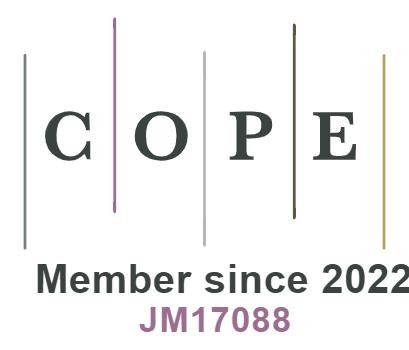Adaptive neural control of vehicular platoons with unknown functions and full state constraints
Abstract
This paper investigates the adaptive neural control of vehicular platoons subject to unknown nonlinear functions and full-state constraints. To address the challenges posed by unknown functions, the neural network technology is integrated into the backstepping control framework. Additionally, the time-varying constraints on position, velocity, and acceleration are effectively managed through the application of tangent barrier Lyapunov functions. Notably, the proposed approach successfully avoids the singularity problem. Based on Lyapunov stability theory, it is rigorously shown that the closed-loop system remains bounded, with system states and error signals strictly confined within the prescribed constraint boundaries. Finally, a numerical example is presented to validate the effectiveness and feasibility of the proposed control scheme.
Keywords
1. INTRODUCTION
Adaptive control is a control strategy that dynamically adjusts its parameters in response to changes in the system, with the goal of enhancing controller performance in uncertain and evolving environments. This approach finds extensive application in fields such as industrial automation[1], cruise system design[2], and traffic management[3,4]. Especially when dealing with model uncertainties and external disturbances, this approach can effectively ensure the stability and tracking performance of the closed-loop system. With the development of modern industry and intelligent transportation systems, the demand for control of complex dynamic systems is increasing, and the research on adaptive control is particularly important. By continuously optimizing and improving adaptive control algorithms, the response speed and accuracy of the system can be enhanced, which provides a theoretical basis and technical support for achieving efficient and safe automation operations. Recently, the rapid acceleration of urbanization has inevitably resulted in increased road congestion and environmental pollution. This phenomenon has adversely impacted travel efficiency, economic growth, and environmental sustainability, placing unprecedented strain on traditional transportation systems. To address these challenges, many cities are exploring intelligent transportation systems and sustainable travel solutions. Among numerous studies, connected automatic vehicles (CAVs) can achieve efficient information sharing and intelligent decision-making through vehicle-to-vehicle (V2V) communication, reduce traffic accidents, execute intelligent scheduling and dynamic route planning, and reduce energy consumption[5–8]. Note that distributed control of vehicular systems can achieve the control objective of the entire system through communication and coordination, and there are significant achievements[9–14]. Specifically, references[9,10] constructed the platoon as a dynamically decoupled system and used distributed model predictive control (DMPC) technology to solve flexible platooning scheduling problems. Reference[11] mainly investigated the distributed adaptive fixed time queue tracking problem of third-order completely non-uniform nonlinear vehicles, and solves the interference problem through robust
On the other hand, the safety issue also needs to be taken seriously, which was not discussed in the above articles[24]. proposed an intermittent privacy protection mechanism to ensure the security of communication data between subsystems. References[25,26] aimed to achieve specified performance queue control and strictly maintain tracking errors within the specified region[27]. constrains the safe distance between vehicles, and[28] simultaneously established constraints on the position and speed of the vehicle platoon. However, references[25–28] ignored the constraint condition on acceleration, which may affect the control performance of the vehicle during rapid braking. Besides, imposing constraints is certainly beneficial for system safety, but at the same time, it can also generate redundant terms, which can cause trouble for control design. Notably, using barrier Lyapunov functions (BLFs) in the process of backstepping design is an effective method to overcome the shortcomings of state constraints. For instance, reference[29] introduced time-varying integral BLFs (IBLFs) into adaptive control design, which ensured the stability of the closed-loop system without violating the constraints of the states[30]. obtained the result of asymptotic convergence of tracking error to zero through logarithm BLFs (log-BLFs) theory analysis. In[31–33], tangent BLFs (tan-BLFs) were used to design an adaptive controller. Subsequently, reference[34]applied BLFs to vehicle platoons and completed stability analysis.
Motivated by the above discussion, this paper is dedicated to researching adaptive neural control of vehicular platoons with unknown functions and full state constraints. Main contributions are summarized as follows.
The composition of the paper is summarized as follows. Section 2 introduces the third-order vehicular platoon and key technologies. Section 3 provides the design process of the adaptive NN controller. Section 4 presents the stability analysis. Section 5 shows an example to validate the effectiveness of the control approach. Section 6 concludes this paper.
2. PROBLEM FORMULATION
As shown in Figure 1, we consider the platoon of CAVs with a bidirectional communication topology of the vehicle ahead and the leading reference signal.
2.1. Vehicle dynamics
Based on[28,34], consider the dynamics of the vehicle
where
where the physical meaning of parameters
Additionally, the engine input
Then substituting (2) into (1), one has
in which
where
The purpose of this paper is to construct an adaptive control scheme to achieve the following three parts:
Accordingly, we make the following assumptions.
Assumption 1.The reference signal
where
Assumption 2.For
and
where
Remark 1.By Assumption 2, the relationship between time-varying functions, positive constants, and state boundaries can be obtained. Based on this assumption and the coordinate transformation between states, virtual controllers, and error signals, we will deduce the constraint boundaries of error signals. This will play a significant role in backstepping design and Lyapunov analysis, ensuring that the closed-loop system is bounded and error signals can converge to bounded compact sets.
Assumption 3.The external disturbance
Lemma 1.[35] For
where
2.2. Radial basis function neural network
The radial basis function neural network (RBFNN) has been widely employed for approximating unknown nonlinear functions. Then
where
where
Besides, the basis function vector is
Here,
Remark 2.In this paper, the RBFNN technique (8) is employed to approximate unknown functions. Although the approximation error inherently exists, it satisfies
Remark 3.For smoothing functions existing in the system, some articles made them known and provided a constant to constrain the boundary, such as Assumption 2 in reference[29]. Unfortunately, this method relies too heavily on precise system models. Although literature[32] sets boundaries for the coupling of known functions and system states for unknown smoothing functions in Assumption 1, this method requires the design of appropriate basis functions. If the proposed assumption cannot characterize the nonlinear characteristics of the unknown function, this will result in errors and lead to a decrease in controller performance. Therefore, we remove these excessive assumptions and not only utilize the RBFNN to approximate any continuous nonlinearities, but also improve the dynamic adaptability of the controller.
3. ADAPTIVE NEURAL CONTROL
In this section, we will design an adaptive NN controller to ensure the boundedness of the vehicular system with unknown functions and full state constraints. To proceed, given the following coordinate transformation
where
Step 1. Based on (1) and (11), one has
By the RBFNN technique, unknown functions can be approximated by
where
Next, we select the following tan-BLF
where
Then we further get
In view of
Substituting (16) into (15), we can obtain
The virtual controller and the adaptive law are designed as
where
in which
Accordingly, it is obvious to deduce that
Furthermore, we substitute (18), (19) and (21) into (17), then
Finally, by defining
Remark 4.In step 1, the virtual controller (18) is ultimately derived through coordinate transformation (11), tan-BLF (14), and the RBFNN technique. The basic design principle is to construct a suitable Lyapunov function, ensuring that its derivative is negative definite or semi-negative definite. Meanwhile, the design of (18) should also incorporate the adaptive law (19) to ensure the convergence of parameter estimation errors and state errors. Therefore, the role of each virtual controller is to stabilize the current subsystem and provide reference inputs for the next subsystem, ultimately achieving the stability of the entire system.
Remark 5.Compared to log-BLF, tan-BLF grows faster when the state approaches the constraint boundary, making the gradient of the Lyapunov function steeper and actively preventing constraint violations. This plays a significant role in systems with full state constraints. In addition, the structure of tan-BLF is more suitable for time-varying constraints because its trigonometric properties can simplify the adaptation to changing boundaries, which is beneficial in constraining dynamic environments that evolve over time.
Remark 6.During the design process, the singularity of the virtual controller has been avoided. When
Therefore, the singularity problem will not happen in (18).
Step 2. Through (1) and (11), one has
By the RBFNN technique, unknown functions can be approximated by
where
Then we select the following tan-BLF
in which
Correspondingly, we further get
In view of
By (29) and (28), one can deduce that
Besides, the virtual controller and the adaptive law are constructed as follows
in which
where
Naturally, we can obtain
Substituting (23), (31), (32) and (34) into (30) will yield
We define
Step 3. Based on (1) and (11), we have
Unknown functions can be approximated by the following RBFNN technique
where
Consider the following tan-BLF
in which
Hence, the derivative of
According to
Based on (41), (42) and (40),
Subsequently, we construct the virtual controller and the adaptive law as
in which
where
Besides, the following inequality is valid
When we substitute (36), (44), (45) and (47) into (43), then
4. STABILITY ANALYSIS
In this section, we summarize the main results in the following Theorem 1 and prove the stability of the closed-loop system.
Theorem 1.Under Assumptions 1-3, we consider the plant (1), virtual controllers (18), (31), adaptive laws (19), (32), (45) and the controller (44). If the initial conditions satisfy
(i) All closed-loop signals are bounded.
(ii) Error signals are kept in bounded sets
(iii) System states remain within constrained boundaries.
Proof. (i) Firstly, we select the Lyapunov function as
By defining
Next we multiply both sides of (50) by
Moreover, the following inequality can also be obtained
Based on the definition of
(ii) According to (52), one has
Therefore, tracking errors are maintained in the following sets
(iii) According to Assumption 2, one gets that
Recalling the transformation (11), we have
Based on the boundedness of
where
Remark 7.Reference[23] studied the CAV platoon with unknown dynamics and communication resource limitations. In contrast, we consider the situation where unknown functions and full state constraints coexist, and design a control scheme based on the RBFNN technology, tan-BLF, and backstepping method. Compared with[25], we investigate more complex third-order vehicle platoons with unknown functions, which makes the proposed control strategy more applicable. In addition, through Lyapunov analysis, it can be proven that both error signals and system states are constrained within the set range, ensuring the safe driving of vehicles.
Remark 8.This paper investigates the vehicle platoon under full state constraints. Firstly, in (4), we provide positive time-varying constraints on states and propose Assumptions 1-2 to ensure the relationship between the constraint boundaries and tracking signals and error signals. Subsequently, suitable tan-BLFs are defined in the backstepping design. In the proof of Theorem 1, we first demonstrate the boundedness of the closed-loop system, and then prove that error signals can converge to bounded compact sets. Finally, based on Assumptions 1-2, the coordinate transformation (11), and bounded compact sets of error signals, it can be concluded that system states always remain within predefined boundaries.
5. SIMULATION
In this section, we will employ an example to illustrate the effectiveness of our control strategy. Next, consider the following vehicular model referred to in[28].
where the external disturbance is
The time-varying boundaries of system states are presented as
Besides, the bounds of error signals are
The parameters of controllers are selected as:
Figure 2-Figure 9 demonstrate the simulation results. Specifically, Figure 2-Figure 4 show the trajectories of the position, velocity and acceleration of the vehicle platoon, which also indicate that system signal can track the reference signal well and the states are kept in the designed bounds. Figure 5-Figure 7 imply that the error signals have not exceeded the boundaries. Figure 8 shows the trajectories of adaptive laws, while Figure 9 depicts the control inputs. Notably, it can be observed from these results that all signals are bounded and control inputs have good convergence performance. Therefore, this bidirectional communication topology enables vehicles to wirelessly exchange information about their position, velocity and acceleration, reducing reliance on a single preceding vehicle and avoiding instability of the platoon caused by a single point of failure. In addition, by fusing the information of the front and rear vehicles, disturbance propagation can be suppressed more quickly. This provides a suitable scheme design and safety considerations for practical vehicle research.
6. CONCLUSIONS
This paper proposes an adaptive neural control strategy for a third-order vehicle platoon with unknown functions and full-state constraints. For safety considerations, we impose time-varying constraints on the position, velocity, and acceleration of the vehicle. Meanwhile, the redundant terms caused by constraints can be eliminated by selecting appropriate tan-BLFs and the singularity issue can be avoided. Besides, we use the NN technique to approximate unknown nonlinearities instead of making too many assumptions, which also simplifies the design process. Finally, an example is utilized to verify the feasibility of the proposed control scheme. Notably, this article does not consider the optimal control scheme and the need to reduce the burden on the platoon communication network. In future research, we will introduce a dynamic programming and event-triggering mechanism to further improve the adaptability of the control algorithm.
DECLARATIONS
Authors' contributions
Made substantial contributions to conception and design of the study and performed data analysis and interpretation: Ma, X.; Di, J.; Tan, C.;
Contributed to approach validation, software simulation, and writing: Ma, X.; Tan, C.; Liu, S.
Contributed to the investigation, supervision, and writing-review and preparation: Di, J.; Liu, S.
Availability of data and materials
Not applicable.
Financial support and sponsorship
This work was supported by the National Natural Science Foundation of China under Grants 62173206, 62473225, 62203261; Taishan Scholar Project of Shandong Province under Grant tsqn202408172; the Science and Technology Support Plan for Youth Innovation of Colleges and Universities in Shandong Province under Grant 2022KJ173; China Postdoctoral Science Foundation under Grant 2021M691849.
Conflicts of interest
Tan, C. is the Guest Editor of the special issue "Adaptive Event-Triggered Control and Optimization for Complex Systems". He is not involved in any steps of editorial processing, notably including reviewers' selection, manuscript handling and decision-making, while the other authors have declared that they have no conflicts of interest.
Ethical approval and consent to participate
Not applicable.
Consent for publication
Not applicable.
Copyright
© The Author(s) 2025.
REFERENCES
1. Villani V., Sabattini L., Bara$$\acute{n}$$ska P., et al. The inclusive system: a general framework for adaptive industrial automation. IEEE. Trans. Autom. Sci. Eng. 2021;18:1969-82.
2. Li Z., Zhao X., Yang J., et al. Model predictive control of multi-objective adaptive cruise system based on extension theory. Complex. Eng. Syst. 2023;3:15.
3. Lin W., Wei H. Cyber-physical models for distributed CAV data intelligence in support of self-organized adaptive traffic signal coordination control. Expert. Syst. Appl. 2023;224:120035.
4. Qin Y., Wang H. Stabilizing mixed cooperative adaptive cruise control traffic flow to balance capacity using car following model. J. Intell. Transp. Syst. 2023;27:57-79.
5. Cui Y., Xu H., Wu J., et al. Automatic vehicle tracking with roadside LiDAR data for the connected-vehicles system. IEEE. Intell. Syst. 2019;34:44-51.
6. Cao Y., Tang K., Sun J., et al. Day-to-day dynamic origin-destination flow estimation using connected vehicle trajectories and automatic vehicle identification data. Transp. Res. Part. C. 2021;129:103241.
7. Ye H., Li G., Juang B. H. Deep reinforcement learning based resource allocation for V2V communications. IEEE. Trans. Veh. Technol. 2019;68:3163-73.
8. Watta P., Zhang X., Murphey Y. Vehicle position and context detection Using V2V communication. IEEE. Trans. Intell. Veh. 2021;6:634-48.
9. Zheng Y., Li S., Li K., et al. Distributed model predictive control for heterogeneous vehicle platoons under unidirectional topologies. IEEE. Trans. Control. Syst. Technol. 2017;25:899-910.
10. Liu P., Kurt A., Ozguner U. Distributed model predictive control for cooperative and flexible vehicle platooning. IEEE. Trans. Control. Syst. Technol. 2019;27:1115-28.
11. Liu Y., Yao D., Wang L., et al. Distributed adaptive fixed-time robust platoon control for fully heterogeneous vehicles. IEEE. Trans. Syst. Man. Cybern. Syst. 2023;53:264-74.
12. Xiao S., Ge X., Han Q., et al. Secure distributed adaptive platooning control of automated vehicles over vehicular Ad-Hoc networks under denial-of-service attacks. IEEE. Trans. Cybern. 2022;52:12003-15.
13. Wang J., Guo J., Li K., et al. Distributed adaptive event-triggered control of connected automated vehicle platoon systems with spoofing cyber attacks. IEEE. Trans. Veh. Technol. 2024;73:18186-97.
14. Zhang X., Du H., Jia Z., et al. An adaptive observer design for denial-of-service attack detection in platoon. Optim. Control. Appl. Methods. 2023;44:2148-65.
15. Lu X., Cannon M., Koksal-Rivet D. Robust adaptive model predictive control: Performance and parameter estimation. Int. J. Robust. Nonlinear. Control. 2021;31:8703-24.
16. Zhang K., Shi Y. Adaptive model predictive control for a class of constrained linear systems with parametric uncertainties. Automatica. 2020;117:108974.
17. Tan C., Gao C., Peng J., et al. Neural-network-based security control for T-S fuzzy system with cooperative event-triggered mechanism. IEEE. Trans. Fuzzy. Syst. 2024;32:4633-45.
18. Li Y., Zhang J., Li Y. Command filter-based adaptive neural tracking control of nonlinear systems with multiple actuator constraints and disturbances. Complex. Eng. Syst. 2024;4:5.
19. Liang Y., Li Y., Khajepour A. A novel combined decision and control scheme for autonomous vehicle in structured road based on adaptive model predictive control. IEEE. Trans. Intell. Transp. Syst. 2022;23:16083-97.
20. Li Y., Zhao Y., Liu W., et al. Adaptive fuzzy predefined-time control for third-order heterogeneous vehicular platoon systems with dead zone. IEEE. Trans. Industr. Inform. 2023;19:9525-34.
21. Guo S., Pan Y., Li H., et al. Dynamic event-driven ADP for n-player nonzero-sum games of constrained nonlinear systems. IEEE. Trans. Autom. Sci. Eng. 2024;22:7657-69.
22. Huang J., Chen J., Yang H., et al. Vehicle platoon tracking control based on adaptive neural network algorithm. Int. J. Control. Autom. Syst. 2023;21:3405-18.
23. Huang L., Xie B., Zhao H., et al. Hierarchical event-triggered control for CAV platoons using adaptive neural network. IEEE. Trans. Intell. Veh. 2024:1-11.
24. Yang S., Liang H., Pan Y., et al. Security control for air-sea heterogeneous multiagent systems with cooperative-antagonistic interactions: An intermittent privacy preservation mechanism. Sci. China. Technol. Sci. 2025;68:1420402.
25. Guo G., Li D. Adaptive sliding mode control of vehicular platoons with prescribed tracking performance. IEEE. Trans. Veh. Technol. 2019;68:7511-20.
26. Guo G., Zhang C. L. Adaptive fault-tolerant control with global prescribed performance of strict-feedback systems. IEEE. Trans. Syst. Man. Cybern. Syst. 2024;54:4832-40.
27. Zhai C., Liu Y., Luo F. A switched control strategy of heterogeneous vehicle platoon for multiple objectives with state constraints. IEEE. Trans. Intell. Transp. Syst. 2019;20:1883-96.
28. Wei J., Liu Y. J., Chen H., et al. Adaptive neural control of connected vehicular platoons with actuator faults and constraints. IEEE. Trans. Intell. Veh. 2023;8:3647-56.
29. Liu L., Gao T., Liu Y. J., et al. Time-varying IBLFs-based adaptive control of uncertain nonlinear systems with full state constraints. Automatica. 2021;129:109595.
30. Lu S., Shen H. Adaptive fuzzy asymptotic tracking control of uncertain nonlinear systems with full state constraints. IEEE. Trans. Fuzzy. Syst. 2024;32:2750-61.
31. Ma L., Wang Z., Wang C. Adaptive neural network state constrained fault-tolerant control for a class of pure-feedback systems with actuator faults. Neurocomputing. 2022;490:431-40.
32. Lin X., Xue J., Zheng E., et al. State-feedback stabilization for high-order output-constrained switched nonlinear systems. IEEE. Trans. Syst. Man. Cybern. Syst. 2022;52:7401-10.
33. Chen A., Tang L., Liu Y. J., et al. Adaptive control for switched uncertain nonlinear systems with time-varying output constraint and input saturation. Int. J. Adapt. Control. Signal. Process. 2019;33:1344-58.
34. Wei J., Liu Y. J., Chen H., et al. Fuzzy adaptive control for vehicular platoons with constraints and unknown dead-zone input. IEEE. Trans. Intell. Transp. Syst. 2023;24:4403-12.
Cite This Article
How to Cite
Download Citation
Export Citation File:
Type of Import
Tips on Downloading Citation
Citation Manager File Format
Type of Import
Direct Import: When the Direct Import option is selected (the default state), a dialogue box will give you the option to Save or Open the downloaded citation data. Choosing Open will either launch your citation manager or give you a choice of applications with which to use the metadata. The Save option saves the file locally for later use.
Indirect Import: When the Indirect Import option is selected, the metadata is displayed and may be copied and pasted as needed.
About This Article
Special Topic
Copyright
Data & Comments
Data
























Comments
Comments must be written in English. Spam, offensive content, impersonation, and private information will not be permitted. If any comment is reported and identified as inappropriate content by OAE staff, the comment will be removed without notice. If you have any queries or need any help, please contact us at [email protected].